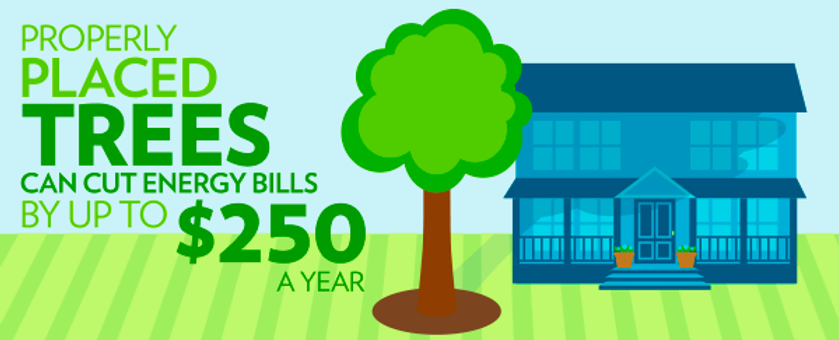If you have ever escaped from the blazing hot sun in a shady spot under a tree, you know how these natural air conditioners can make you feel more comfortable. A mature shade tree can block up to 90 percent of solar radiation, which could translate to a significant reduction in your home cooling cost. A Pennsylvania study found that air conditioning needs could be reduced by up to 75 percent by shading a house with trees!
Computer models devised by the U.S. Department of Energy predict that the proper placement of as few as three shade trees will save an average household $100 to $250 in energy costs each year – and that study was done before energy costs soared!
Reduce energy use
On hot days, some large trees can pull hundreds of gallons of water through their leaves. This water evaporates, keeping the tree and its immediate surroundings cool. With the less-than-efficient use of fossil fuels for heating and cooling our buildings, it only makes good sense to take advantage of the following principles.
“Plant deciduous trees on the south and west sides of a building,” advises Tchukki Andersen, BCMA, CTSP* staff arborist with the Tree Care Industry Association. “Those are the sides where the sun’s rays are most intense. Since deciduous trees lose their leaves in winter, they offer shade during summer but permit the winter sun to provide warmth,” adds Andersen. “Where there isn’t room for trees, shrubs and vines can provide similar benefits.”
Deciduous trees with high, spreading crowns can be planted to the south of your home to provide maximum summertime roof shading. Trees with branches lower to the ground are more appropriate to the west, where shade is needed from lower afternoon sun angles. Trees should not be planted on the southern sides of homes in cold climates because the branches of these trees will block some winter sun.
“Although a slow-growing tree may require many years of growth before it shades your roof, it will generally live longer than a fast-growing tree,” notes Andersen. Also, because slow-growing trees often have deeper roots and stronger branches, they are less prone to fail during windstorms or heavy snowstorms. Slow-growing trees can also be more drought resistant than fast-growing trees.
Trees, shrubs and groundcover plants can also shade the ground and pavement around the home. This reduces heat radiation and cools the air before it reaches your home’s walls and windows. Use a large bush or row of shrubs to shade a patio or driveway. Plant a hedge to shade a sidewalk. Build a trellis for climbing vines to shade a patio area.
Shrubs planted close to the house will fill in rapidly and begin shading walls and windows within a few years. However, avoid allowing dense foliage to grow immediately next to a home where wetness or continual humidity can be a problem.
Enhance property values
Beyond energy savings and beauty, homeowners who take care of their trees find the value of their properties increase. A number of studies have shown that real estate agents and home buyers assign between 10 and 23 percent of the value of a residence to the trees on the property.
What can you do?
Many arborists have training in ecosystem services, including energy efficient landscapes, which is a growing branch of tree appraisal. ArborTech Tree Care can assess your landscape, provide information regarding the value potential of your trees and work with you to determine the best trees and shrubs to plant for your existing landscape.





